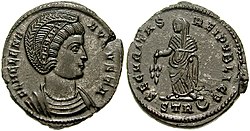JESUS THE CHRIST TOMB DISCOVERED
ON SEPTEMBER 14 ,326 A.D. BY HELENA ,
THE MOTHER OF CONSTANTINE THE GREAT
 |
| Helena of Constantinople by Cima da Conegliano |
| St. Helena | |
|---|---|

Coin of Flavia Iulia Helena, mother of Constantine I. Æ Follis (19mm, 3.45 gm). Treveri (Trier) mint. Struck 325–326 AD.
| |
| Empress; Mother of Constantine the Great | |
| Born | c. 246/50 possibly at Helenopolis Bithynia,Asia Minor |
| Died | c. 327/30 Rome |
| Venerated in | |
| Canonized | Pre-Congregation[1] |
| Major shrine | The shrine to St. Helena in St. Peter's Basilica |
| Feast | 18 August (Roman Catholic Church); 21 May (Orthodox, Anglican, and most Lutheran Churches); 19 May (some Lutheran Churches); 9 Pashons(Coptic Orthodox Church) |
| Attributes | Cross |
| Patronage | archaeologists, converts, difficult marriages, divorced people, empresses, Saint Helena island |
She is revered as a saint by the Eastern Orthodox Church, Oriental Orthodox Church, Roman Catholic Church, and the Anglican Communion, and the Lutheran Church commemorates her.
Constantine appointed his mother Helena as Augusta Imperatrix, and gave her unlimited access to the imperial treasury in order to locate the relics of Judeo-Christian tradition.
In 326-28 Helena undertook a trip to the Holy Places in Palestine. According to Eusebius of Caesarea she was responsible for the construction or beautification of two churches, the Church of the Nativity, Bethlehem, and the Church on the Mount of Olives, sites of Christ's birth and ascension, respectively. Local founding legend attributes to Helena's orders the construction of a church in Egypt to identify the Burning Bush of Sinai. The chapel at Saint Catherine's Monastery—often referred to as the Chapel of Saint Helen—is dated to the year AD 330.
Jerusalem was still being rebuilt following the destruction caused by Emperor Hadrian. He had built a temple over the site of Jesus's tomb near Calvary, and renamed the city Aelia Capitolina.
Accounts differ concerning whether the Temple was dedicated to Venus or Jupiter[23] According to tradition, Helena ordered the temple torn down and, according to the legend that arose at the end of the 4th century, chose a site to begin excavating, which led to the recovery of three different crosses.
The legend is recounted in Ambrose, On the Death of Theodosius (died 395) and at length in Rufinus' chapters appended to his translation into Latin of Eusebius' Ecclesiastical History,
the main body of which does not mention the event.[24] Then, Rufinus relates, the empress refused to be swayed by anything short of solid proof and performed a test. Possibly through Bishop Macarius of Jerusalem, she had a woman who was near death brought from the city.
When the woman touched the first and second crosses, her condition did not change, but when she touched the third and final cross she suddenly recovered,[25] and Helena declared the cross with which the woman had been touched to be the True Cross. On the site of discovery,
Constantine ordered the building of the Church of the Holy Sepulchre; churches were also built on other sites detected by Helena. Sozomen and Theodoret claim that Helena also found the nails of the crucifixion. To use their miraculous power to aid her son, Helena allegedly had one placed in Constantine's helmet, and another in the bridle of his horse.
Helena left Jerusalem and the eastern provinces in 327 to return to Rome, bringing with her large parts of the True Cross and other relics, which were then stored in her palace's private chapel,
where they can be still seen today. Her palace was later converted into the Basilica of the Holy Cross in Jerusalem. This has been maintained by Cistercian monks in the monastery which has been attached to the church for centuries







No comments:
Post a Comment